G. Gary Wang
Hybrid Metaheuristic Vehicle Routing Problem for Security Dispatch Operations
Mar 03, 2025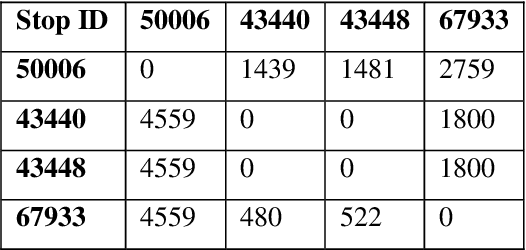
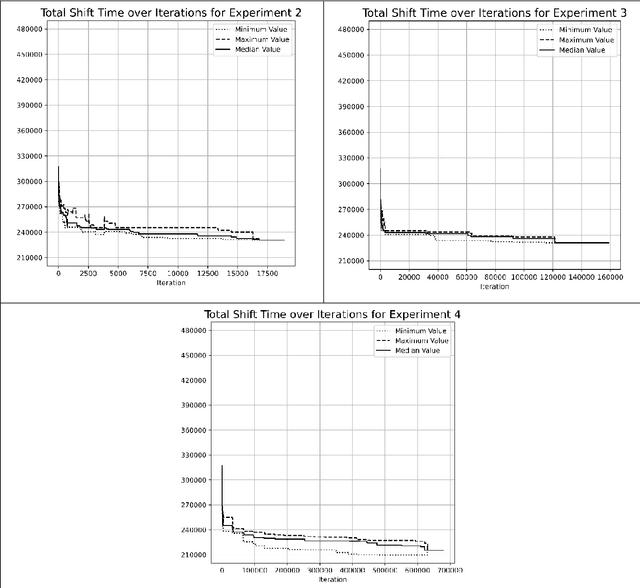


Abstract:This paper investigates the optimization of the Vehicle Routing Problem for Security Dispatch (VRPSD). VRPSD focuses on security and patrolling applications which involve challenging constraints including precise timing and strict time windows. We propose three algorithms based on different metaheuristics, which are Adaptive Large Neighborhood Search (ALNS), Tabu Search (TS), and Threshold Accepting (TA). The first algorithm combines single-phase ALNS with TA, the second employs a multiphase ALNS with TA, and the third integrates multiphase ALNS, TS, and TA. Experiments are conducted on an instance comprising 251 customer requests. The results demonstrate that the third algorithm, the hybrid multiphase ALNS-TS-TA algorithm, delivers the best performance. This approach simultaneously leverages the large-area search capabilities of ALNS for exploration and effectively escapes local optima when the multiphase ALNS is coupled with TS and TA. Furthermore, in our experiments, the hybrid multiphase ALNS-TS-TA algorithm is the only one that shows potential for improving results with increased computation time across all attempts.
Selecting Subsets of Source Data for Transfer Learning with Applications in Metal Additive Manufacturing
Jan 16, 2024Abstract:Considering data insufficiency in metal additive manufacturing (AM), transfer learning (TL) has been adopted to extract knowledge from source domains (e.g., completed printings) to improve the modeling performance in target domains (e.g., new printings). Current applications use all accessible source data directly in TL with no regard to the similarity between source and target data. This paper proposes a systematic method to find appropriate subsets of source data based on similarities between the source and target datasets for a given set of limited target domain data. Such similarity is characterized by the spatial and model distance metrics. A Pareto frontier-based source data selection method is developed, where the source data located on the Pareto frontier defined by two similarity distance metrics are selected iteratively. The method is integrated into an instance-based TL method (decision tree regression model) and a model-based TL method (fine-tuned artificial neural network). Both models are then tested on several regression tasks in metal AM. Comparison results demonstrate that 1) the source data selection method is general and supports integration with various TL methods and distance metrics, 2) compared with using all source data, the proposed method can find a small subset of source data from the same domain with better TL performance in metal AM regression tasks involving different processes and machines, and 3) when multiple source domains exist, the source data selection method could find the subset from one source domain to obtain comparable or better TL performance than the model constructed using data from all source domains.
Real-Time 2D Temperature Field Prediction in Metal Additive Manufacturing Using Physics-Informed Neural Networks
Jan 04, 2024Abstract:Accurately predicting the temperature field in metal additive manufacturing (AM) processes is critical to preventing overheating, adjusting process parameters, and ensuring process stability. While physics-based computational models offer precision, they are often time-consuming and unsuitable for real-time predictions and online control in iterative design scenarios. Conversely, machine learning models rely heavily on high-quality datasets, which can be costly and challenging to obtain within the metal AM domain. Our work addresses this by introducing a physics-informed neural network framework specifically designed for temperature field prediction in metal AM. This framework incorporates a physics-informed input, physics-informed loss function, and a Convolutional Long Short-Term Memory (ConvLSTM) architecture. Utilizing real-time temperature data from the process, our model predicts 2D temperature fields for future timestamps across diverse geometries, deposition patterns, and process parameters. We validate the proposed framework in two scenarios: full-field temperature prediction for a thin wall and 2D temperature field prediction for cylinder and cubic parts, demonstrating errors below 3% and 1%, respectively. Our proposed framework exhibits the flexibility to be applied across diverse scenarios with varying process parameters, geometries, and deposition patterns.
Online Thermal Field Prediction for Metal Additive Manufacturing of Thin Walls
Oct 24, 2023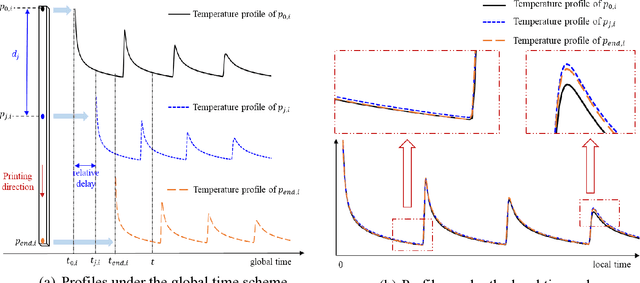
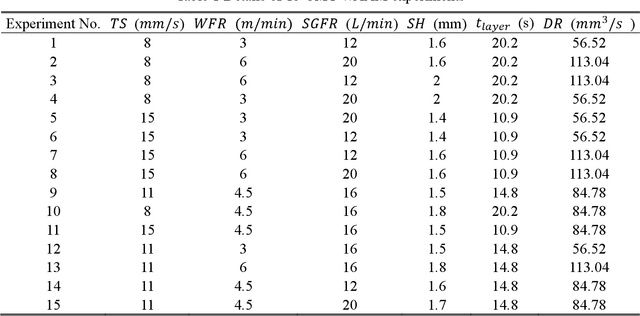
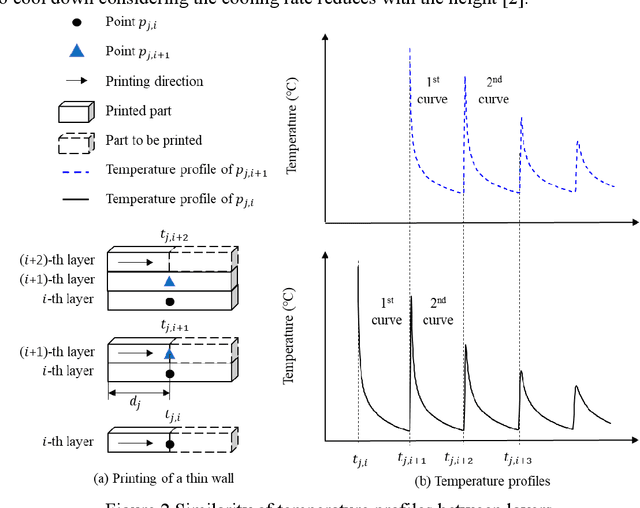
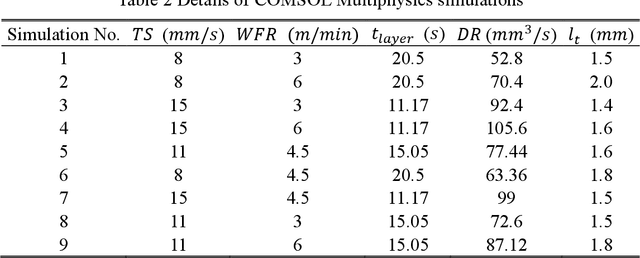
Abstract:This paper aims to study a practical issue in metal AM, i.e., how to predict the thermal field of yet-to-print parts online when only a few sensors are available. This work proposes an online thermal field prediction method using mapping and reconstruction, which could be integrated into a metal AM process for online performance control. Based on the similarity of temperature curves (curve segments of a temperature profile of one point), the thermal field mapping applies an artificial neural network to estimate the temperature curves of points on the yet-to-print layer from measured temperatures of certain points on the previously printed layer. With measured/predicted temperature profiles of several points on the same layer, the thermal field reconstruction proposes a reduced order model (ROM) to construct the temperature profiles of all points on the same layer, which could be used to build the temperature field of the entire layer. The training of ROM is performed with an extreme learning machine (ELM) for computational efficiency. Fifteen wire arc AM experiments and nine simulations are designed for thin walls with a fixed length and unidirectional printing of each layer. The test results indicate that the proposed prediction method could construct the thermal field of a yet-to-print layer within 0.1 seconds on a low-cost desktop. Meanwhile, the method has acceptable generalization capability in most cases from lower layers to higher layers in the same simulation and from one simulation to a new simulation on different AM process parameters. More importantly, after fine-tuning the proposed method with limited experimental data, the relative errors of all predicted temperature profiles on a new experiment are sufficiently small, demonstrating the applicability and generalization of the proposed thermal field prediction method in online applications for metal AM.
System identification and closed-loop control of laser hot-wire directed energy deposition using the parameter-signature-property modeling scheme
Oct 18, 2023Abstract:Hot-wire directed energy deposition using a laser beam (DED-LB/w) is a method of metal additive manufacturing (AM) that has benefits of high material utilization and deposition rate, but parts manufactured by DED-LB/w suffer from a substantial heat input and undesired surface finish. Hence, monitoring and controlling the process parameters and signatures during the deposition is crucial to ensure the quality of final part properties and geometries. This paper explores the dynamic modeling of the DED-LB/w process and introduces a parameter-signature-property modeling and control approach to enhance the quality of modeling and control of part properties that cannot be measured in situ. The study investigates different process parameters that influence the melt pool width (signature) and bead width (property) in single and multi-layer beads. The proposed modeling approach utilizes a parameter-signature model as F_1 and a signature-property model as F_2. Linear and nonlinear modeling approaches are compared to describe a dynamic relationship between process parameters and a process signature, the melt pool width (F_1). A fully connected artificial neural network is employed to model and predict the final part property, i.e., bead width, based on melt pool signatures (F_2). Finally, the effectiveness and usefulness of the proposed parameter-signature-property modeling is tested and verified by integrating the parameter-signature (F_1) and signature-property (F_2) models in the closed-loop control of the width of the part. Compared with the control loop with only F_1, the proposed method shows clear advantages and bears potential to be applied to control other part properties that cannot be directly measured or monitored in situ.
Comparison of Transfer Learning based Additive Manufacturing Models via A Case Study
May 17, 2023
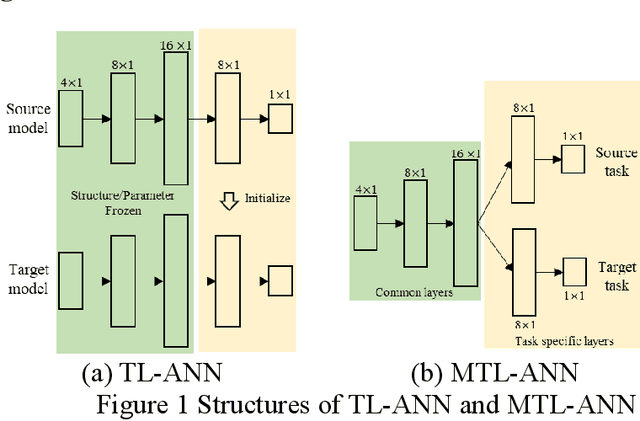


Abstract:Transfer learning (TL) based additive manufacturing (AM) modeling is an emerging field to reuse the data from historical products and mitigate the data insufficiency in modeling new products. Although some trials have been conducted recently, the inherent challenges of applying TL in AM modeling are seldom discussed, e.g., which source domain to use, how much target data is needed, and whether to apply data preprocessing techniques. This paper aims to answer those questions through a case study defined based on an open-source dataset about metal AM products. In the case study, five TL methods are integrated with decision tree regression (DTR) and artificial neural network (ANN) to construct six TL-based models, whose performances are then compared with the baseline DTR and ANN in a proposed validation framework. The comparisons are used to quantify the performance of applied TL methods and are discussed from the perspective of similarity, training data size, and data preprocessing. Finally, the source AM domain with larger qualitative similarity and a certain range of target-to-source training data size ratio are recommended. Besides, the data preprocessing should be performed carefully to balance the modeling performance and the performance improvement due to TL.
 Add to Chrome
Add to Chrome Add to Firefox
Add to Firefox Add to Edge
Add to Edge